Enhanced Direct Reactive Power Control-Based Multi-Level Inverter for DFIG Wind System under Variable Speeds
Abstract
1. Introduction
- A new non-linear control strategy based on fuzzy DRPC applied to a three-level inverter (DRPC-3N) that supplied the rotor of the DFIG-WT system while considering random wind variations and all DFIG’s operation modes, even the overspeed case. The new DRPC-3N has been introduced to solve the problem of ripples and power quality during all operation modes, even the overspeed case.
- The FC’s member functions and the fuzzy rules are modified using numerical tests in a way to solve WT-DFIG system constraints and drawbacks faced by the conventional controls.
- The performance and quality of the proposed method and topology are tested under certain restrictions that reflect the actual wind behavior for a power plant, like the stochastic nature of wind velocity with the treatment of all operation modes (sub-synchronous, super-synchronous, and synchronous modes, as well as the overspeed) in a continual and successive manner.
- The MPPT algorithm has been invested to optimize the generated power under the three operation modes: sub-, super-, and synchronous modes, while the pitch angle control has been used under the overspeed to limit the generated power.
- The performances of the proposed DRPC-3N are compared to DRPC-2N, where the robustness tests and the ripples of reactive power, rotor flux, and electromagnetic as well as the generated current’s THD have been analyzed to show the significant improvement of the proposed strategy.
2. Description of the Proposed Energy System
2.1. Wind Turbine Working Zones Description
2.2. Maximum Power Point Tracking Description
2.3. Pitch Angle Control Description
3. Description of the Proposed Direct Reactive Power Control
3.1. Direct Torque Control of the Three-Level Inverter Description
3.2. The Proposed Fuzzy PID Design and Local Reactive Power Compensation Description
4. Simulation Results
- (1)
- Robustness and tracking tests of references for random profiles of the setpoints:In this case, the objective is to analyze the performances of the proposed topology from the point of view of robustness and tracking to the sudden and random variations in references. This will be done while going through all the operating modes of the DFIG in a random and continuous way; as a generator of active power, according to the profile of the wind speed, passing from the sub-synchronous mode to the synchronous and super-synchronous modes until the overspeed. Then as a local compensator of the reactive power. This reflects a behavior close to the real operation of a power plant. In this part two topologies are treated, while comparing the one proposed in this work to another one based on a two-level inverter.The total hourly averages of the wind speed data, up to 360 s (6 min), and the DFIG mechanical speed profiles are presented in Figure 5. Figure 6 illustrates the β, λ, and Cp. When the power reached its maximum value, the pitch angle control was activated. Therefore, the DFIG speed is maintained at its maximum amount. Then, the electromagnetic torque is maintained constant, but the reactive power followed the AC grid demand for both topologies, as presented in Figure 7. However, in regions I and II, the generated active power is maximized by the MPPT algorithm, as presented in Figure 8. This figure shows that all the powers transferred between the WT-DFIG system and the AC grid for both topologies, respectively. The rotor power (Pr) switches its direction, marked by its sign, according to the generator slip; this reflects two operating modes, sub- and super-synchronous, through the synchronous mode, as presented in Figure 9a–c.The control performance can be analyzed in the reference’s pursuit of the DFIG mechanical speed, the electromagnetic torque, the reactive power, and the rotor flux as illustrated respectively in Figure 7 and Figure 10. The Ωmec and Tem vary according to the wind speed profile to maximize the generated active power in zones I and II of the WT characteristic. Meanwhile, in zone III, both Ωmec and Tem are kept constant to limit the produced power. Therefore, the rotor flux magnitude is maintained at its reference and changes depending on the involved reactive power compensation, as shown in Figure 10.The WT-DFIG operates in the optimal way where the possibility of using the DFIG to control and manage the active–reactive powers is confirmed. Hence, these results affirm the good performances and the robustness of the proposed DRPC control. In addition, it can be clearly noticed that the torque ripples are decreased by about 65% compared to the results given in references [1,18,19].The two axes rotor flux waveforms (Φrα and Φrβ) are presented Figure 11a–c, with a sinusoidal behavior during sub- and super-synchronous modes. Nevertheless, both rotor flux components (Φrα and Φrβ) have a continuous behavior during the synchronous mode. Additionally, the rotor phase currents have a direct waveform during this particular mode, as shown in Figure 12c. The sinusoidal behavior of the rotor phase currents can be noticed during the other modes: sub- and super-synchronous as shown in Figure 12a,b. The random evolution of the rotor current magnitude is related to the electromagnetic torque variations and its pulsation is dependent on the slip variations.The generated AC grid current keeps a sinusoidal of a constant frequency (50Hz) form throughout all operating modes, along with a variable amplitude, as shown in Figure 13, Figure 14 and Figure 15.The proposed control-enhanced DRPC applied to a DFIG three-level inverter, the waveforms of the generated currents supplying the AC grid, are significantly improved compared to that of the two-level inverter, as studied in [1,19], with a low THD, as illustrated in Figure 16a–c. Furthermore, there was an almost constant frequency of 50 Hz. This indicates the improved energy quality produced to supply the AC grid.
- (2)
- Tests of reference tracking for profiles in steps of the setpoints:The objective in this part is to analyze the performances of reference tracking of the proposed topology (DPRC-3N), compared to DRPC-2N. The choice of the two profiles, wind speed and reactive power to be compensated locally, is based on:
- Ensuring full operation of a local reactive power compensator. By switching from operating in unit power factor mode (QAC = 0 Var), then in excess reactive power consumption mode (QAC > 0 Var), to deficit reactive power generation mode in the grid connection bar set, as illustrated in Figure 20.
The references tracking is very remarkable on the obtained results, as illustrated in Figure 19, Figure 20, Figure 21 and Figure 22, respectively, the DFIG mechanical speed, the reactive power, the electromagnetic torque and the rotor flux, for both topologies (DPRC-3N and DPRC-2N). The DFIG speed and Tem vary with the wind speed profile to maximize the active power generated using the MPPT algorithm, as shown in Figure 23 and Figure 24. Therefore, the rotor flux amplitude is kept at its reference and varies according to the local compensation of the reactive power involved.The waveforms of the rotor flux components in the α-β frame (Φrα and Φrβ) with that of currents ira and ira, zoomed during all DFIG operation modes, confirm the results shown in Figure 11, Figure 12, Figure 13, Figure 14, Figure 15 and Figure 16, as presented in Figure 25, Figure 26 and Figure 27.The proposed control-enhanced DRPC applied to a DFIG three-level inverter (DRPC-3N), the waveforms of the generated currents supplying the AC grid, are significantly improved compared to that of the two-level inverter (DRPC-2N), with a low THD, as illustrated in Figure 15 and Figure 16a–c. Additionally, there was an almost constant frequency of 50 Hz. This indicates the improved power quality produced to supply the AC grid. - (3)
- Robustness tests against parametric variations:In this part, the effect of temperature increase during the operation of the DFIG is taken into account. This causes an increase in the generator winding resistances (Rs and Rr). Then, the effect of saturation of the DFIG magnetic circuit on the behavior of the proposed DRPC-3N is analyzed. This saturation decreases the mutual self-inductance (M) between the DFIG stator and rotor, which causes the cyclic self-inductances of each winding to decrease (Ls and Lr).This is made in two separate tests:
- The first one is to assume that after the operation of the wind generator, the heating of the stator and rotor windings increases the resistances (Rs and Rr) by 100% of their nominal values, as presented in Figure 28a.
- The second is to consider that the saturation of the magnetic circuit of the DFIG causes a decrease in the value of the natural mutual between the stator and rotor windings (M) of 20%. This action directly decreases the cyclic inductances values of each winding (Ls and Lr), as presented in Figure 28b.
Setpoint profiles have been selected in a way to test the different DFIG operating modes, while accommodating all speed modes (super-synchronous and sub-synchronous modes passing through the synchronous mode) as well as the three compensation regimes (QAC > 0, QAC < 0, and QAC = 0), as shown in Figure 29, Figure 30, Figure 31, Figure 32 and Figure 33.From the results obtained for both topologies (DPRC-3N and DRPC-2N), it can be clearly seen that both techniques show a very good robustness with respect to the parametric variations, but the ripples band is always small in the case of the proposed DRPC-3N compared to DRPC-2N. Knowing that, the major handicap of DTC is the sensitivity to the resistance which intervenes in the estimation of the flux. In this case, the combination of DTC and fuzzy logic reinforces this robustness as shown in the different obtained results, as shown in Figure 30, Figure 31, Figure 32 and Figure 33, particularly Figure 32a. In this figure which represents the rotor flux, whatever the evolution of the rotor resistance (Rr), which intervenes in the estimation of this flux, the latter always remains insensitive to these variations. This confirms that the proposed DRPC, whether DRPC-2N or DRPC-3N, is very robust technique to machine parametric variations. - (4)
- Summary of the obtained results with comparison:A comparative analysis between DRPC-2N and the improved DRPC (DRPC-3N) of ripples of: electromagnetic torque, rotor flux, and the generated and local reactive power compensation with the generated current THD and its frequency during different DFIG operation modes is summarized in Table 4 and Table 5. All ripples caused by both strategies are illustrated in Figure 34, Figure 35, Figure 36, Figure 37 and Figure 38.As expected, their ripples are low in the case of DRPC-3N while they are important in the DRPC-2N topology. Indeed, the proposed DRPC-3N allows for the reduction of the ripples of the electromagnetic torque, generated active power, and the rotor flux magnitude by about 60.7%, 15.25%, and 30.3%, respectively. Furthermore, those of the compensation reactive power are minimized by about 20.1%.In addition, the ripple of the grid-supplied phase current frequency in both control strategies is illustrated in Figure 35, and the ripples of this frequency is summarized in Table 4. It can be noticed that, when using the DRPC-3N topology, the frequency is almost constant with a mean value of 50.00 Hz with an error of 1.50%, which is better than that obtained in the case of DRPC-2N. Therefore, the AC grid generated current frequency ripples reduction in DRPC-3N compared to DRPC-2N is about 50.80%.Furthermore, with the proposed control topology (DRPC-3N), the waveforms supplying the AC grid are significantly improved compared to that of DRPC-2N with a total harmonic distortion (THD) largely below 1%, (above this value should be reported as mentioned by IEC standards) as presented in Figure 16a–c and Table 5. This confirms a better quality of generated power that supplied the AC grid. Moreover, the total losses decrease, leading to this approach having the best efficiency.Moreover, to better power quality performance, the proposed DRPC-3N technique is very robust to parametric variations in the machine as well as to sudden and random variations in reference quantity profiles.
5. Conclusions
Author Contributions
Funding
Data Availability Statement
Acknowledgments
Conflicts of Interest
Appendix A

References
- Tamalouzt, S.; Benyahia, N.; Rekioua, T.; Abdessemed, R. Performances analysis of WT-DFIG with PV and fuel cell hybrid power sources system associated with hydrogen storage hybrid energy system. Int. J. Hydrogen Energy 2016, 41, 21006–21021. [Google Scholar] [CrossRef]
- Shihabudheen, K.V.; Pillai, G.N.; Raju, S.K. Neuro-Fuzzy Control of DFIG Wind Energy System with Distribution Network. Electr. Power Compon. Syst. 2018, 46, 1416–1431. [Google Scholar] [CrossRef]
- Jaladi, K.K.; Sandh, K.S. Real-time simulator based hybrid controller of DFIG-WES during grid faults design and analysis. Electr. Power Energy Syst. 2020, 116, 105545. [Google Scholar] [CrossRef]
- Kerrouche, K.D.E.; Mezouar, A.; Belgacem, K. Decoupled Control of Doubly Fed Induction Generator by Vector Control for Wind Energy Conversion System. Energy Procedia 2013, 42, 239–248. [Google Scholar] [CrossRef]
- Adjoudj, M.; Abid, M.; Aissaoui, A.; Ramdani, Y.; Bounoua, H. Sliding mode control of a doubly fed induction generator for wind turbines. Rev. Roum. Sci. Techn. Electrotechn. Energ. 2011, 56, 15–24. [Google Scholar]
- Abdelfatteh, A.; Abid, M. Hybrid fuzzy sliding mode control of a doubly fed induction generator in wind turbines. Rev. Roum. Sci. Techn. Electrotechn. Energ. 2012, 57, 15–24. [Google Scholar]
- Hicham, S.; Benattous, D. Sensorless Optimal Power Control of Doubly Fed Induction Wind Generator Based on Extended Kalman Filter. Electroteh. Electron. Autom. 2017, 65, 34–41. [Google Scholar]
- Belabbas, B.; Allaoui, T.; Tadjine, M.; Denai, M. High Order Sliding Mode Controller Simulation by a Wind Turbine for DFIG Protection against Overcurrent. Electroteh. Electron. Autom. 2017, 65, 142–147. [Google Scholar]
- Fihakhir, A.M.; Bouhamida, M. Nonlinear Control of a Doubly Fed Induction Generator Driven Wind Turbine. Electroteh. Electron. Autom. 2016, 64, 23–32. [Google Scholar]
- Hu, J.; Yuan, X. VSC-based direct torque and reactive power control of doubly fed induction generator. Renew. Energy 2012, 40, 13–23. [Google Scholar] [CrossRef]
- Yaichi, I.; Semmah, A.; Wira, P.; Djeriri, Y. Super-twisting Sliding Mode Control of a Doubly-fed Induction Generator Based on the SVM Strategy. Period. Polytech. Electr. Eng. Comput. Sci. 2019, 63, 178–190. [Google Scholar] [CrossRef]
- Kassem, A.M.; Hasaneen, K.M.; Yousef, A.M. Dynamic modeling and robust power control of DFIG driven by wind turbine at infinite grid. Int. J. Electr. Power Energy Syst. 2013, 44, 375–382. [Google Scholar] [CrossRef]
- Taib, N.; Metidji, B.; Rekioua, T. A Fixed Switching Frequency Direct Torque Control Strategy for Induction Motor Drives Using Indirect Matrix Converter. Arab. J. Sci. Eng. 2014, 39, 2001–2011. [Google Scholar] [CrossRef]
- Arbi, J.; Ghorbal, M.J.-B.; Slama-Belkhodja, I.; Charaabi, L. Direct Virtual Torque Control for Doubly Fed Induction Generator Grid Connection. IEEE Trans. Ind. Electron. 2009, 56, 4163–4173. [Google Scholar] [CrossRef]
- Ben Alaya, J.; Khedher, A.; Mimouni, M.F. Speed-sensorless DFIG wind drive based on DTC using sliding mode rotor flux observer. Int. J. of Renew. Energ. Res. 2012, 2, 735–745. [Google Scholar]
- Payam, A.F.; Hashemnia, M.N.; Fai, J. Robust DTC Control of Doubly-Fed Induction Machines Based on Input-Output Feedback Linearization Using Recurrent Neural Networks. J. Power Electron. 2011, 11, 719–725. [Google Scholar] [CrossRef]
- Prasad, R.M.; Mulla, M.A. Mathematical Modeling and Position-Sensorless Algorithm for Stator-Side Field-Oriented Control of Rotor-Tied DFIG in Rotor Flux Reference Frame. IEEE Trans. Energy Convers. 2020, 35, 631–639. [Google Scholar] [CrossRef]
- Tamalouzt, S.; Idjdarene, K.; Rekioua, T.; Abdessemed, R. Direct Torque Control of Wind Turbine Driven Doubly Fed Induction Generator. Rev. Roum. Sci. Tech. Electrotech. Energ. 2016, 61, 244–249. [Google Scholar]
- Tamalouzt, S.; Rekioua, T.; Abdessemed, R. Direct torque and reactive power control of Grid Connected Doubly Fed Induction Generator for the wind energy conversion. In Proceedings of the 2014 International Conference on Electrical Sciences and Technologies in Maghreb (CISTEM), Tunis, Tunisia, 3–6 November 2014; pp. 1–7. [Google Scholar]
- Suganthi, L.; Iniyan, S.; Samuel, A.A. Applications of fuzzy logic in renewable energy systems—A review. Renew. Sustain. Energy Rev. 2015, 48, 585–607. [Google Scholar] [CrossRef]
- Louarem, S.; Belkhiat, S.; Belkhiat, D.E.C. A control method using PI/fuzzy controllers based DFIG in wind energy conversion system. In Proceedings of the 2013 IEEE Grenoble Conference, Grenoble, France, 16–20 June 2013; pp. 1–6. [Google Scholar]
- Meddouri, S.; Idjdarene, K.; Ferrarini, L. Control of Autonomous Saturated Induction Generator Associated to a Flywheel Energy Storage System. Rev. Roum. Sci. Tech. Electrotech. Energ. 2016, 61, 372–377. [Google Scholar]
- Nami, A.; Liang, J.; Dijkhuizen, F.; Demetriades, G.D. Modular Multilevel Converters for HVDC Applications: Review on Converter Cells and Functionalities. IEEE Trans. Power Electron. 2015, 30, 18–36. [Google Scholar] [CrossRef]
- Nami, A.; Zare, F. Multilevel Converters in Renewable Energy Systems; Renewable Energy; Hammons, T.J., Ed.; IntechOpen: Rijeka, Croatia, 2009. [Google Scholar] [CrossRef][Green Version]
- Lega, A. Multilevel Converters: Dual Two-Level Inverter Scheme. Ph.D. Thesis, Electrical Engineering, University of Bologna, Bologna, Italy, 2007; pp. 39–51. [Google Scholar]
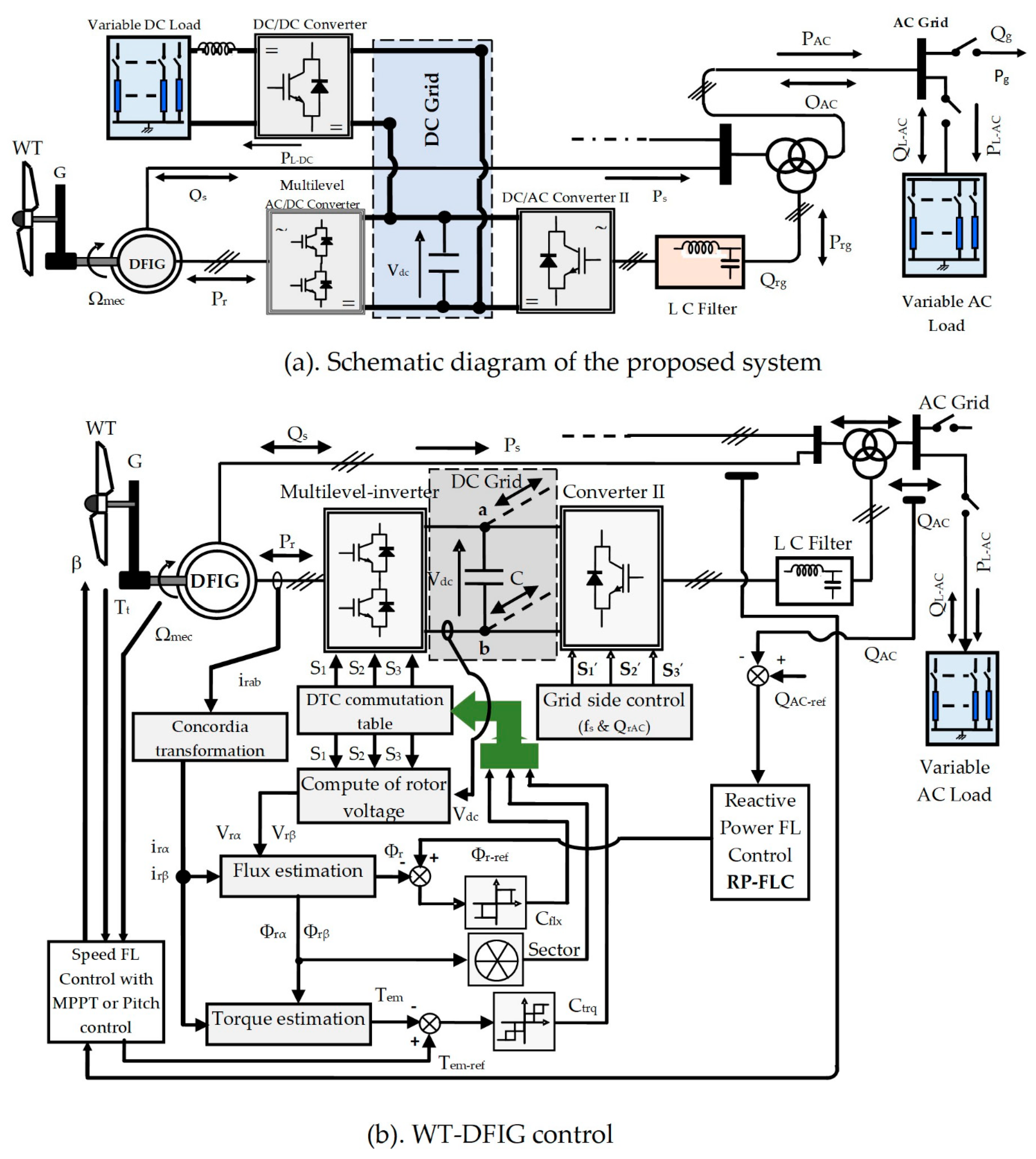
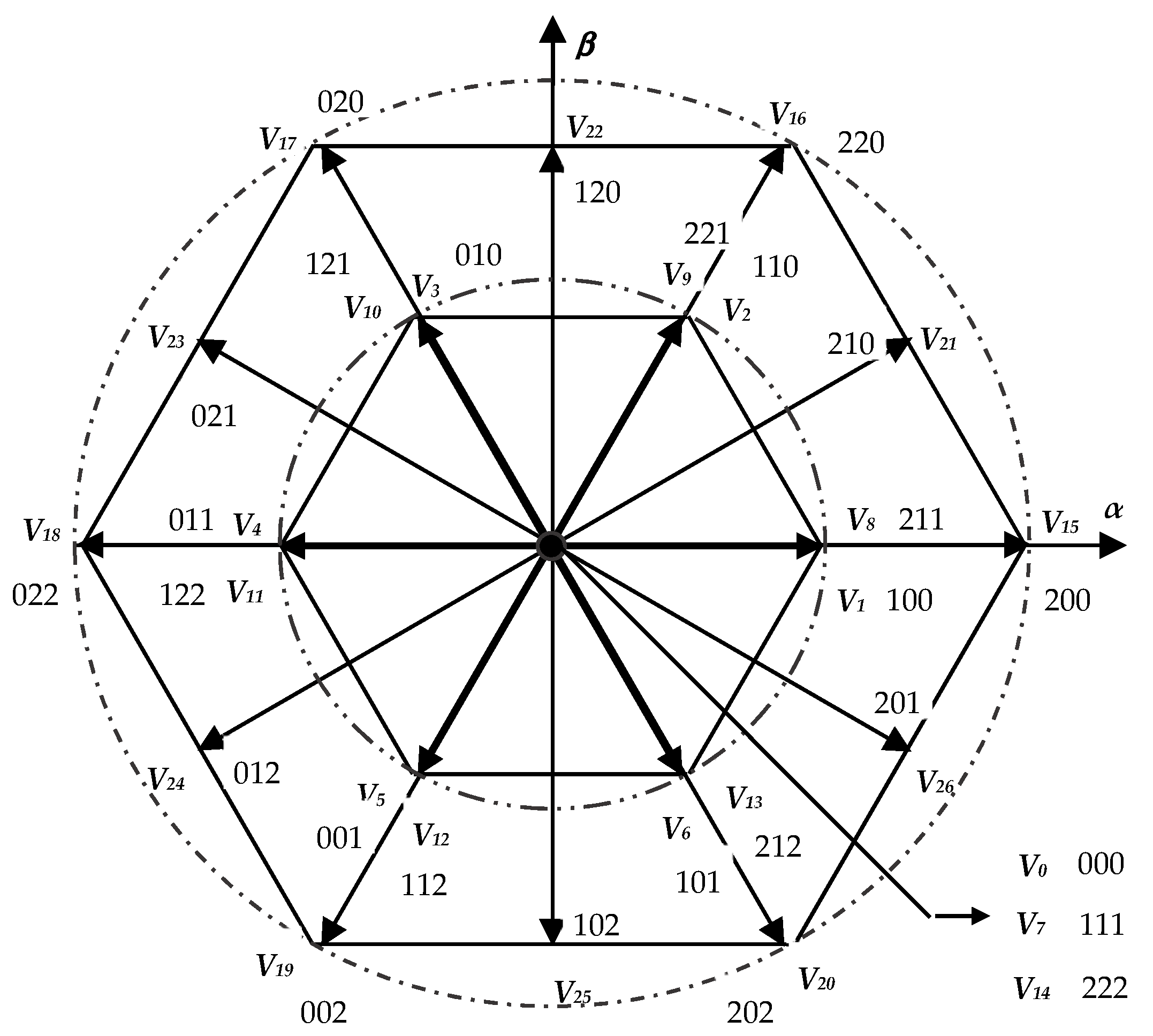
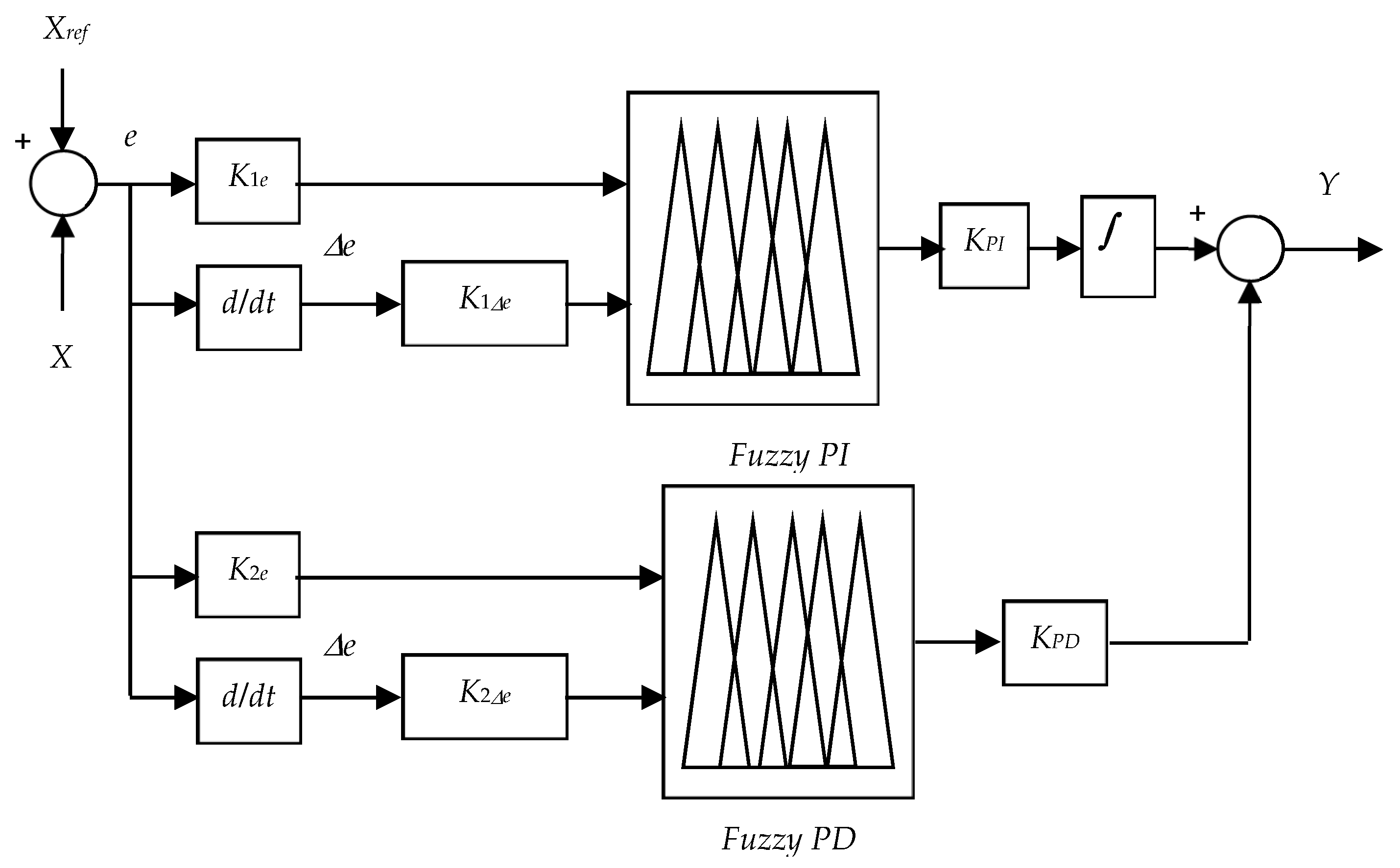


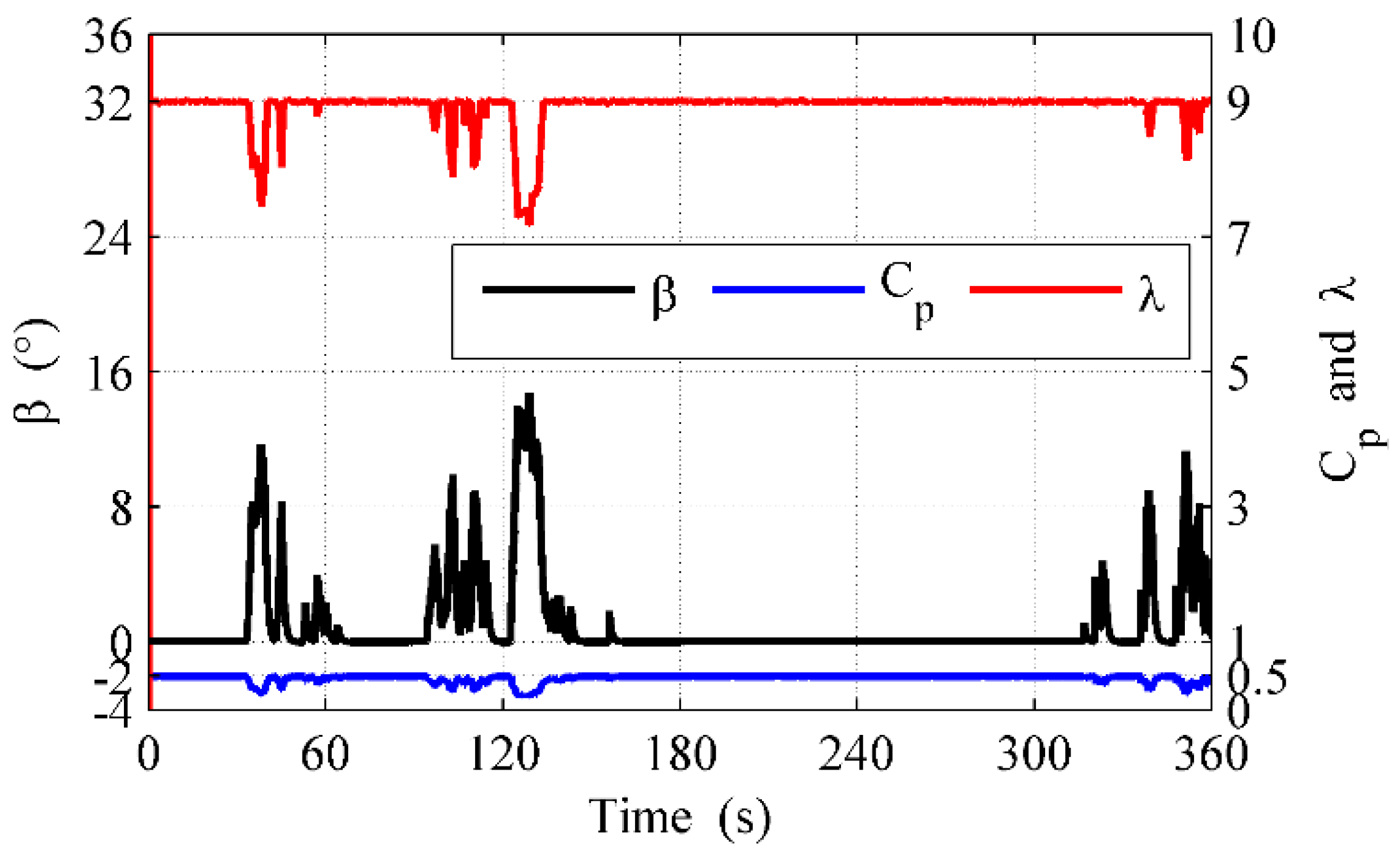
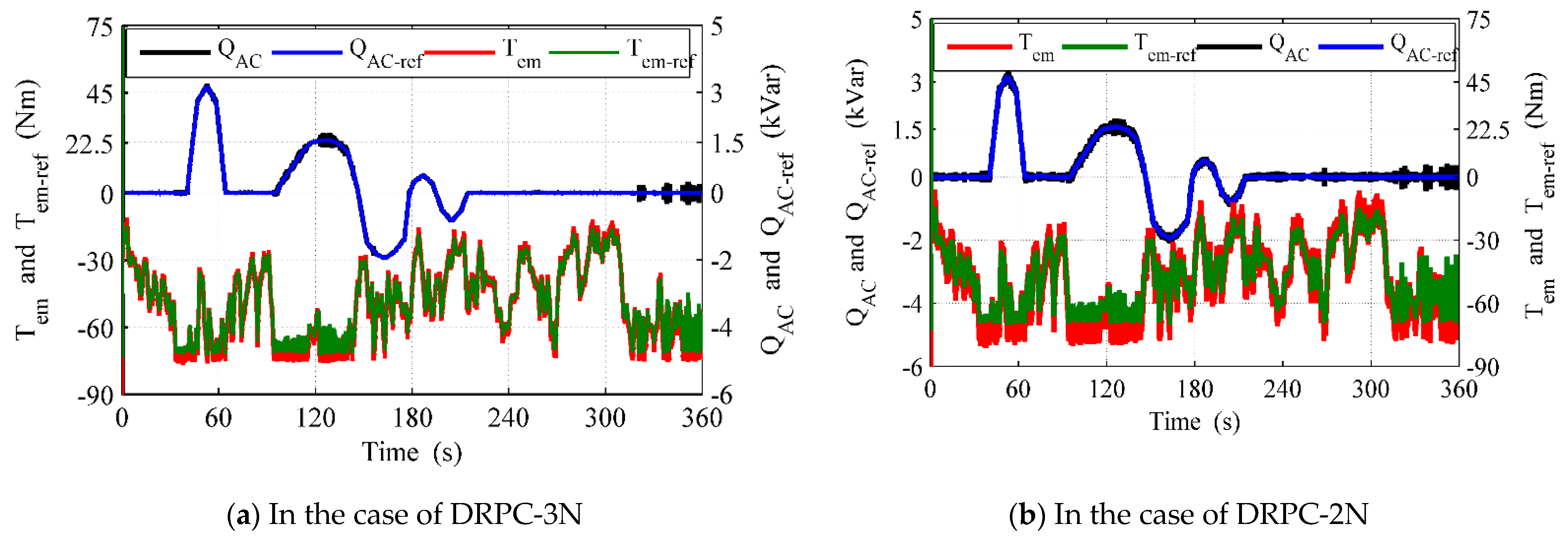
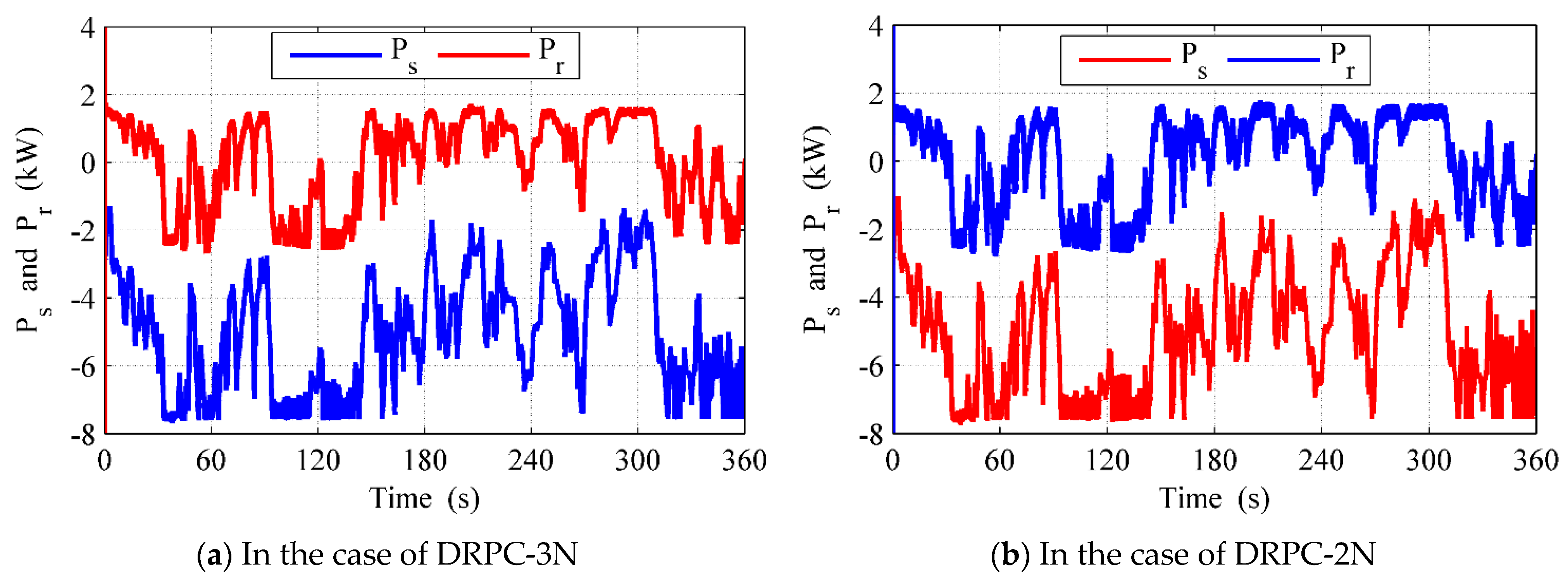

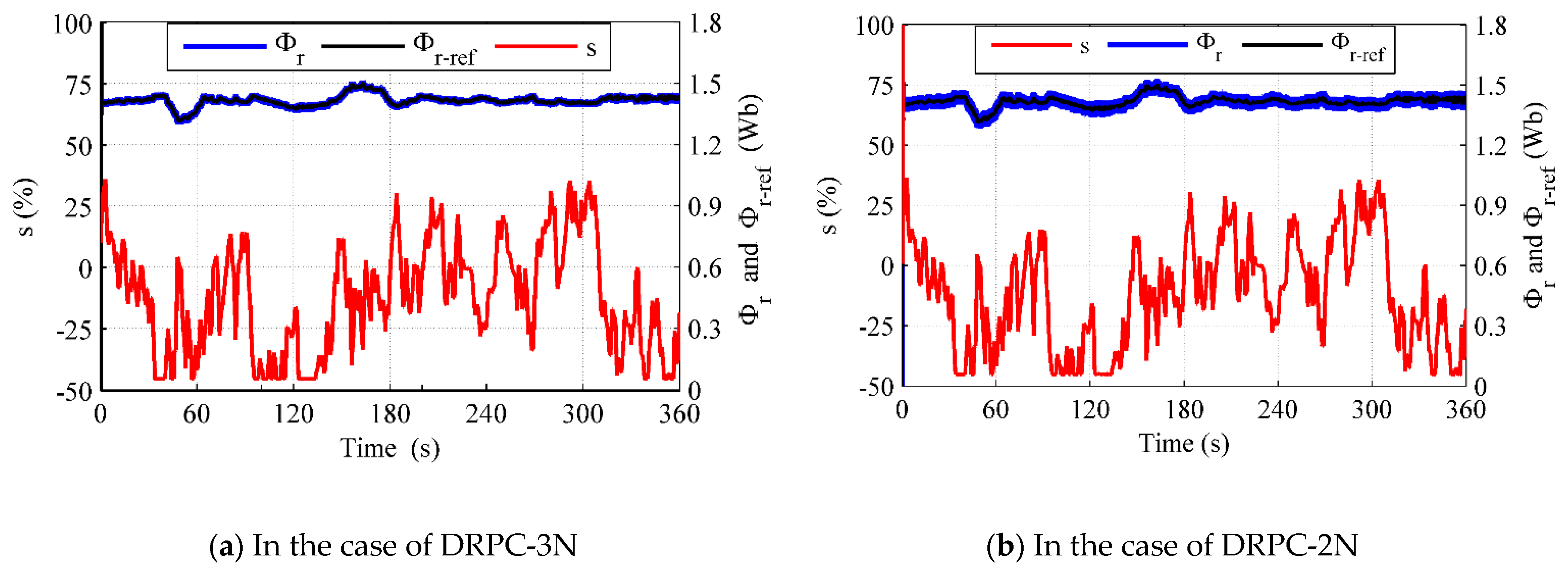



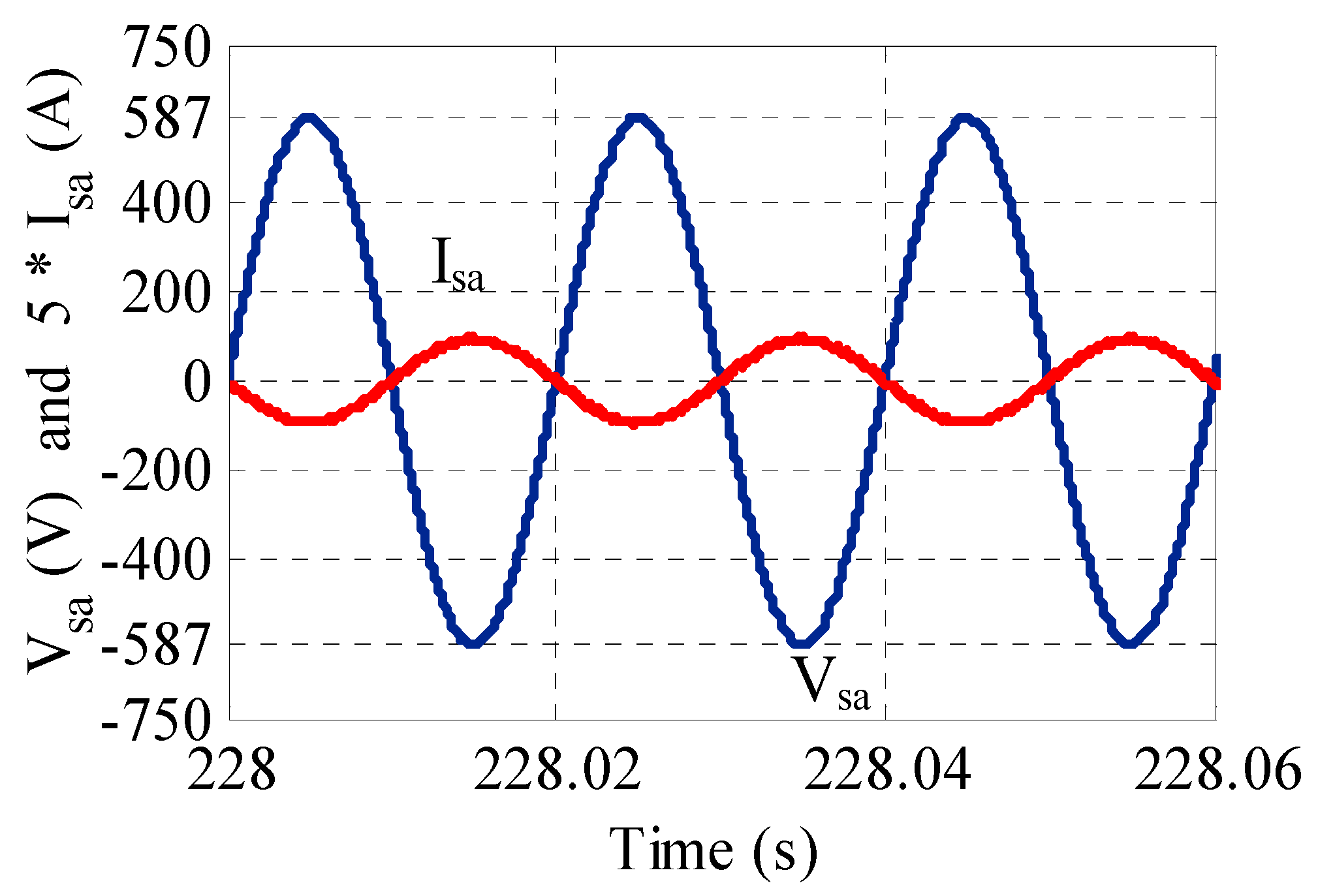

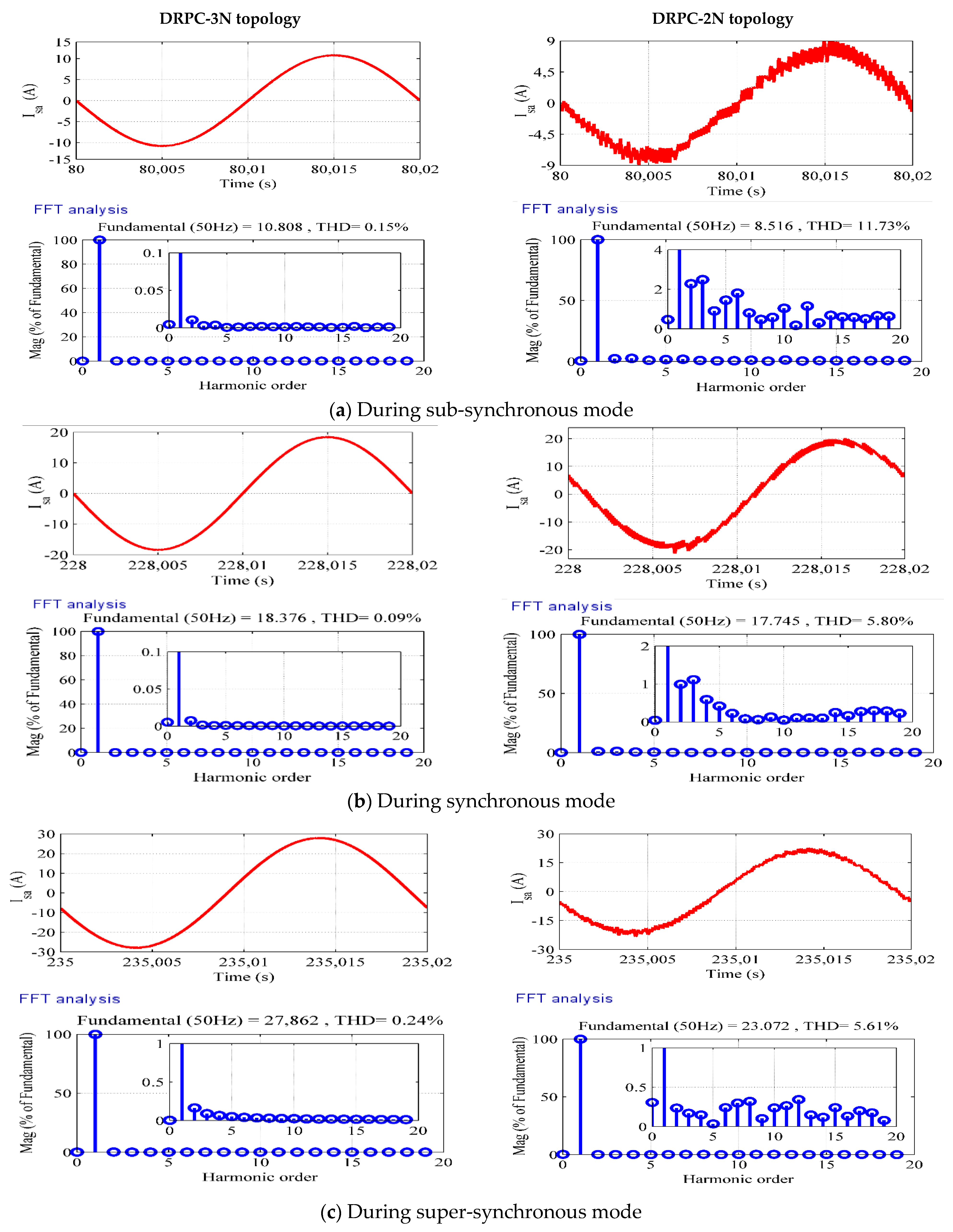

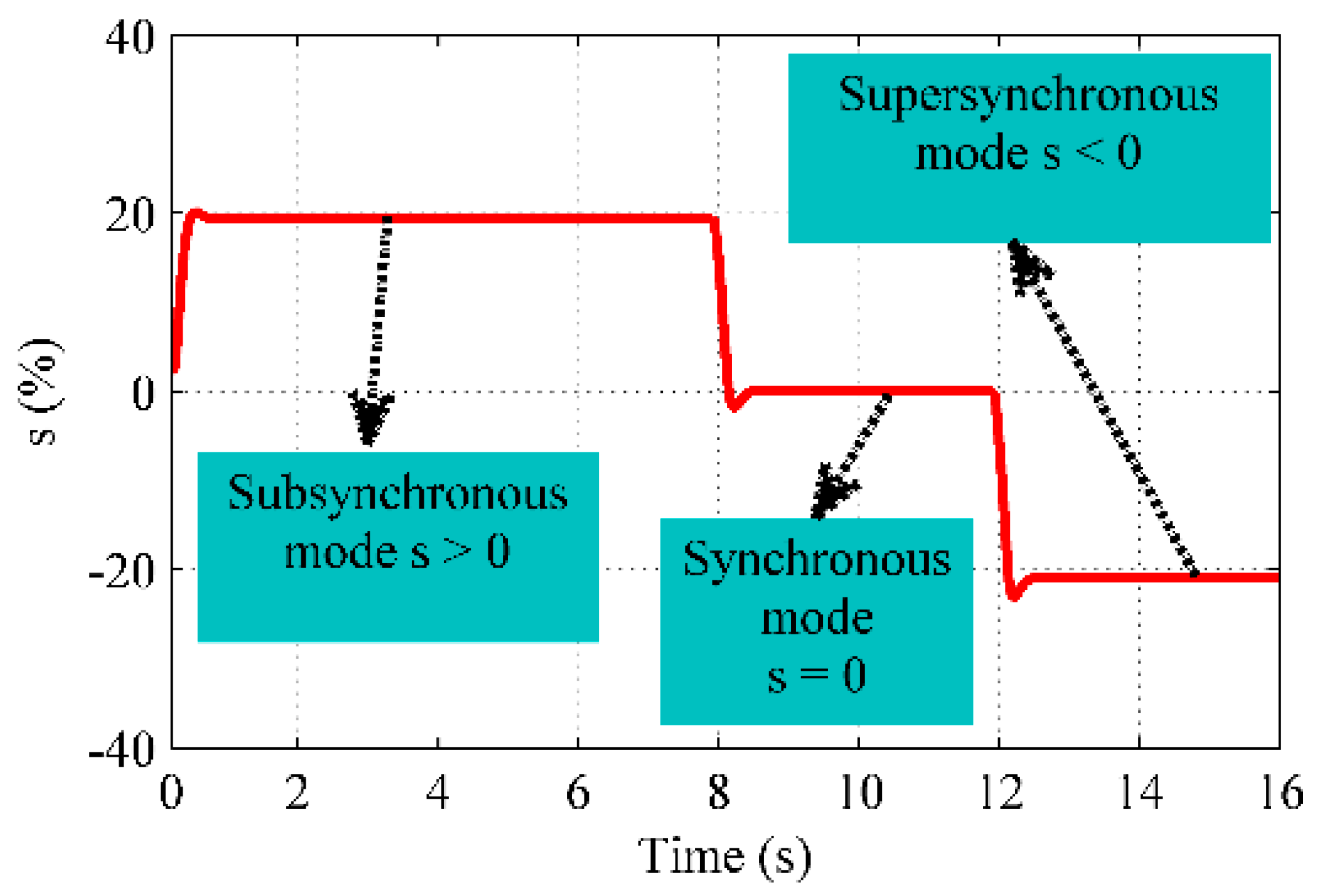
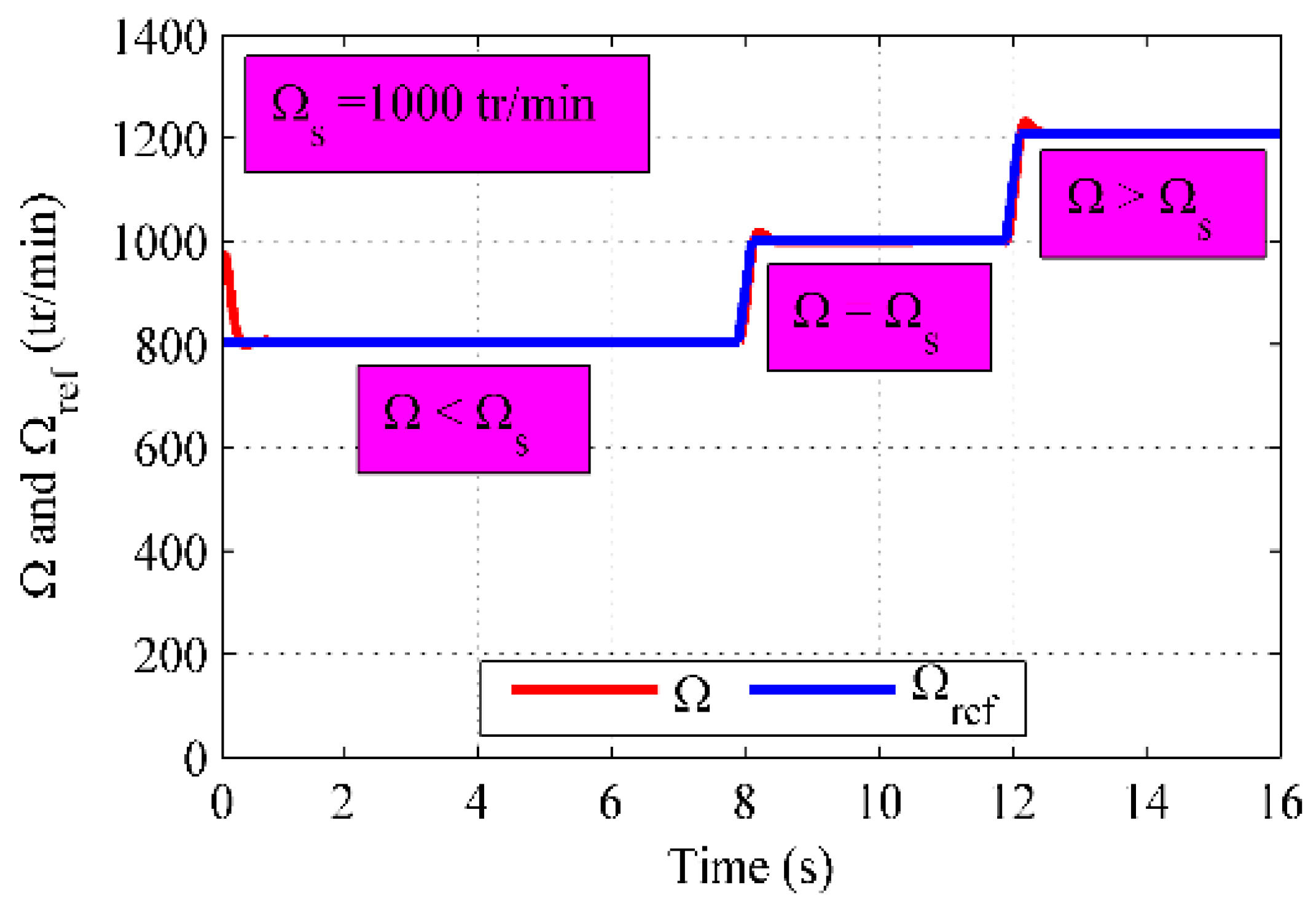
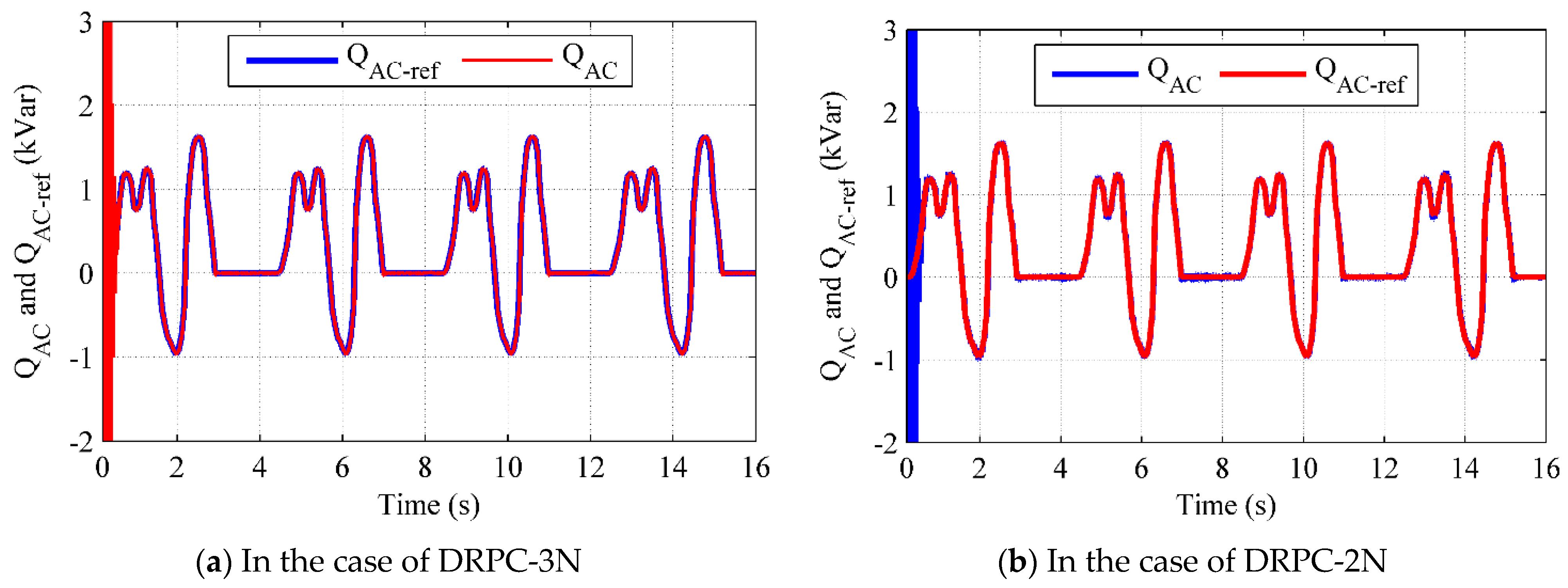
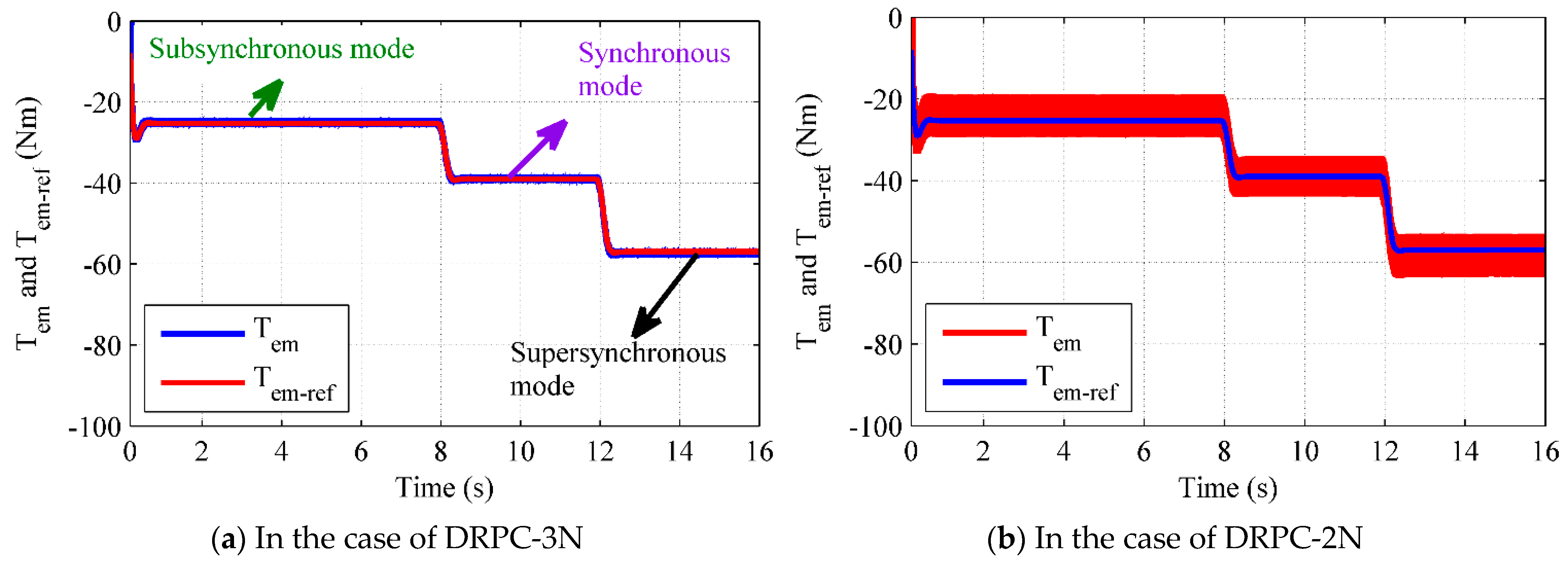


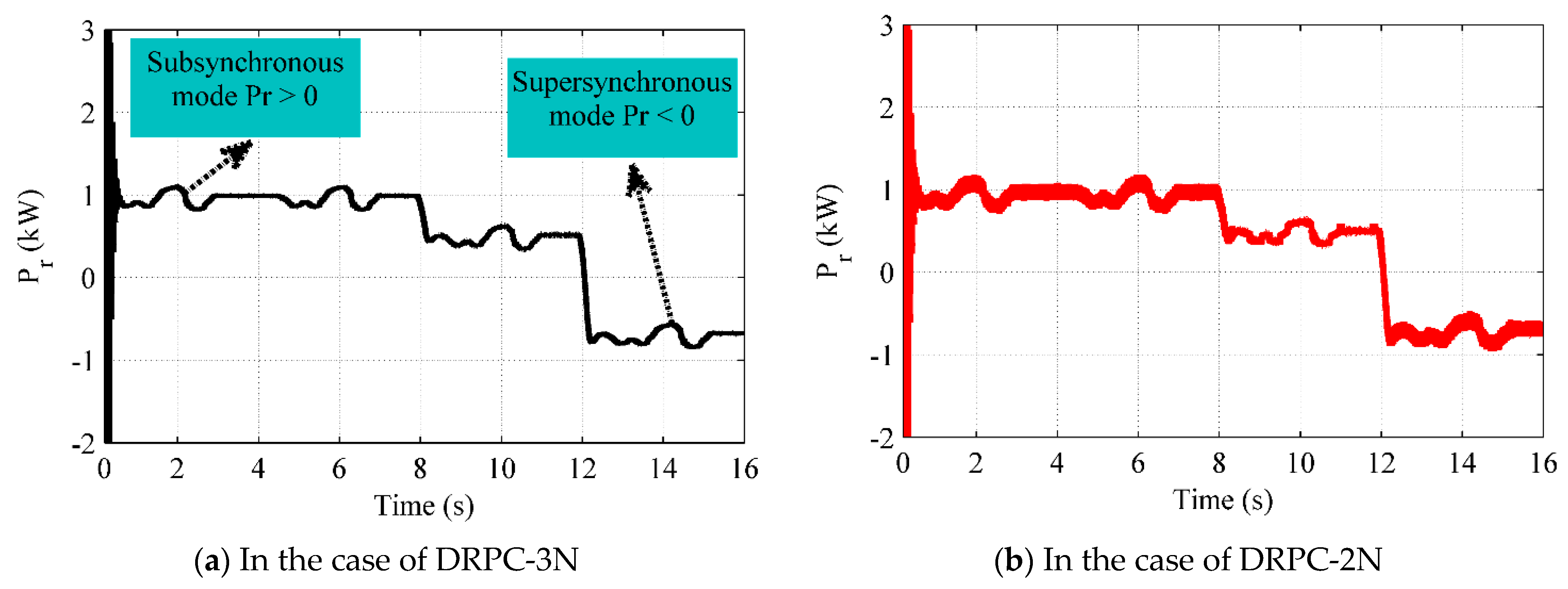

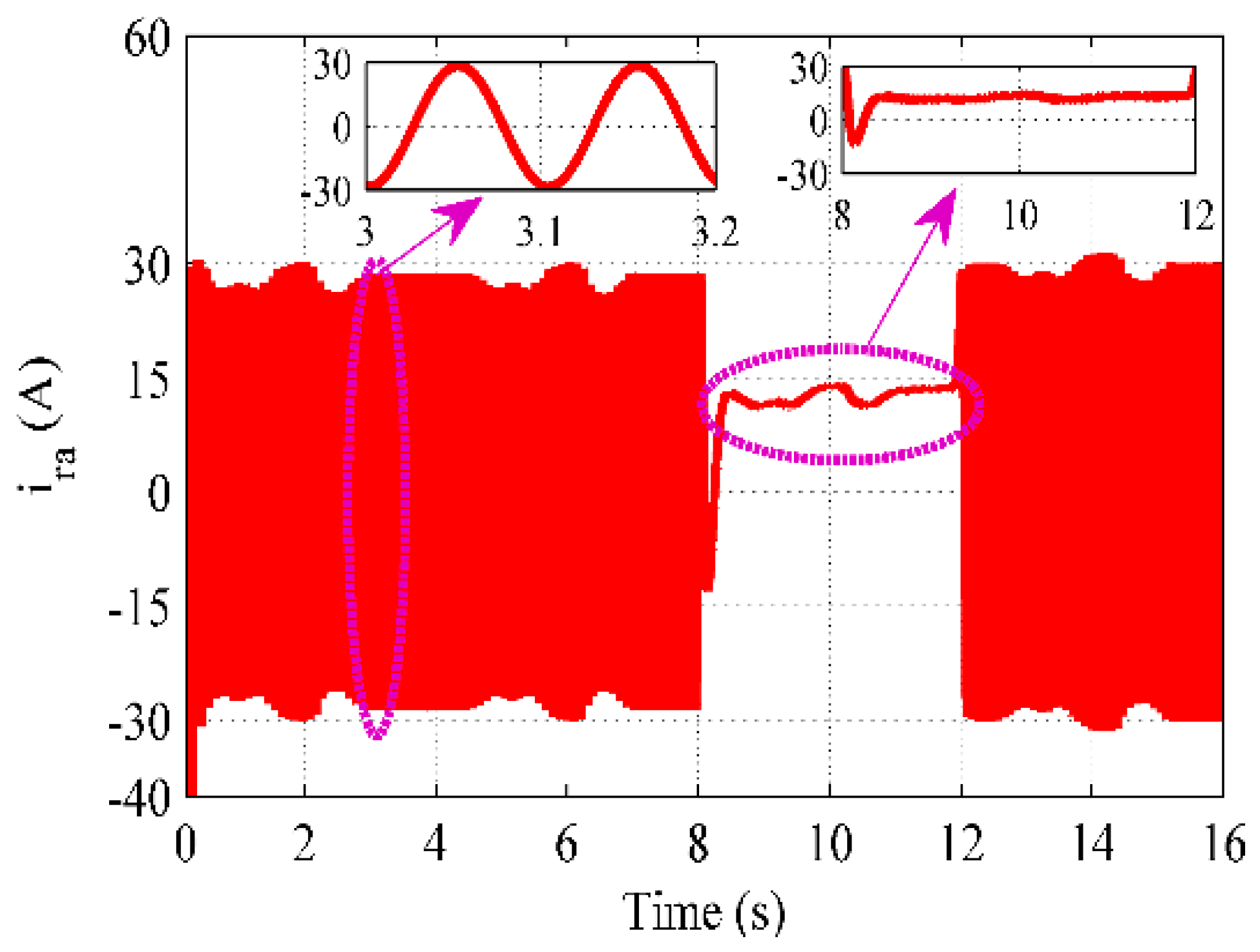
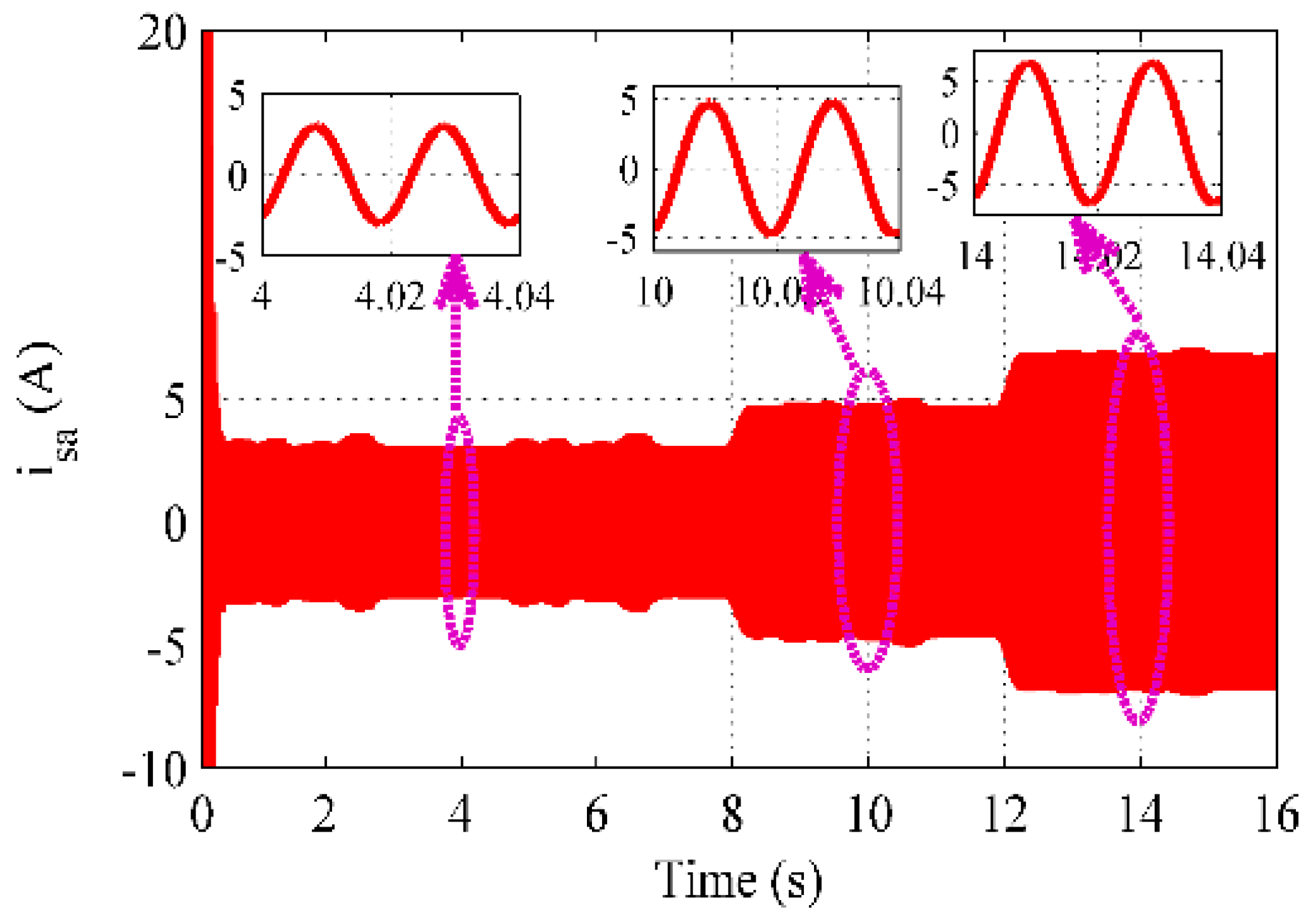

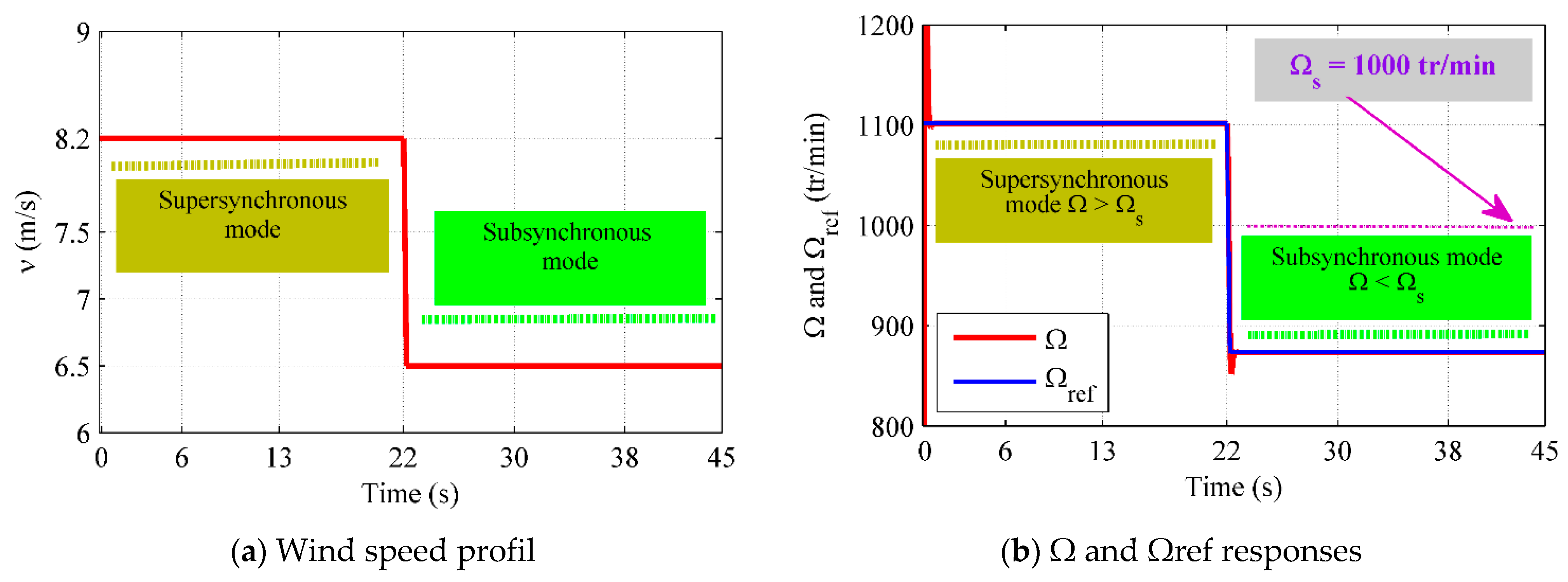


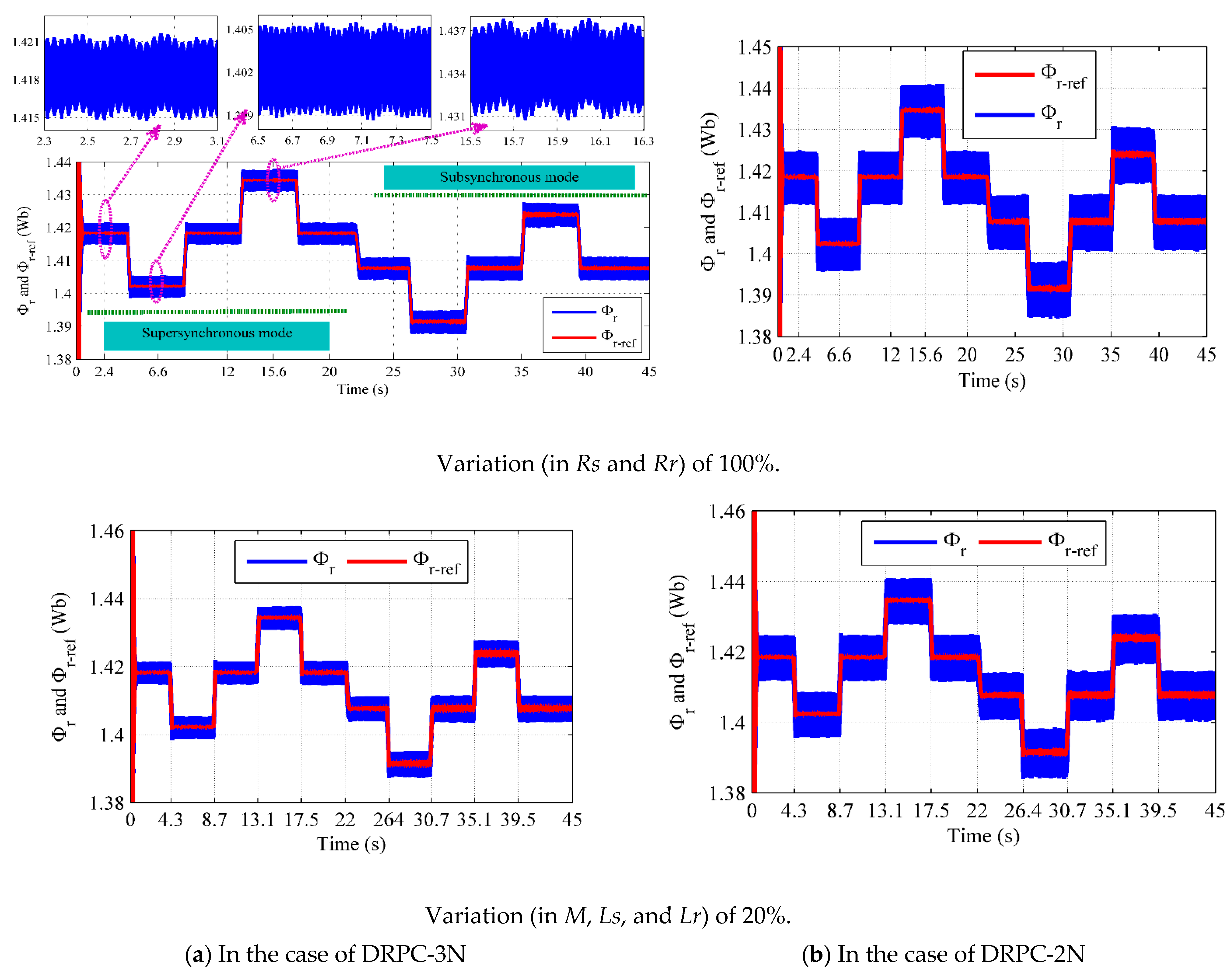
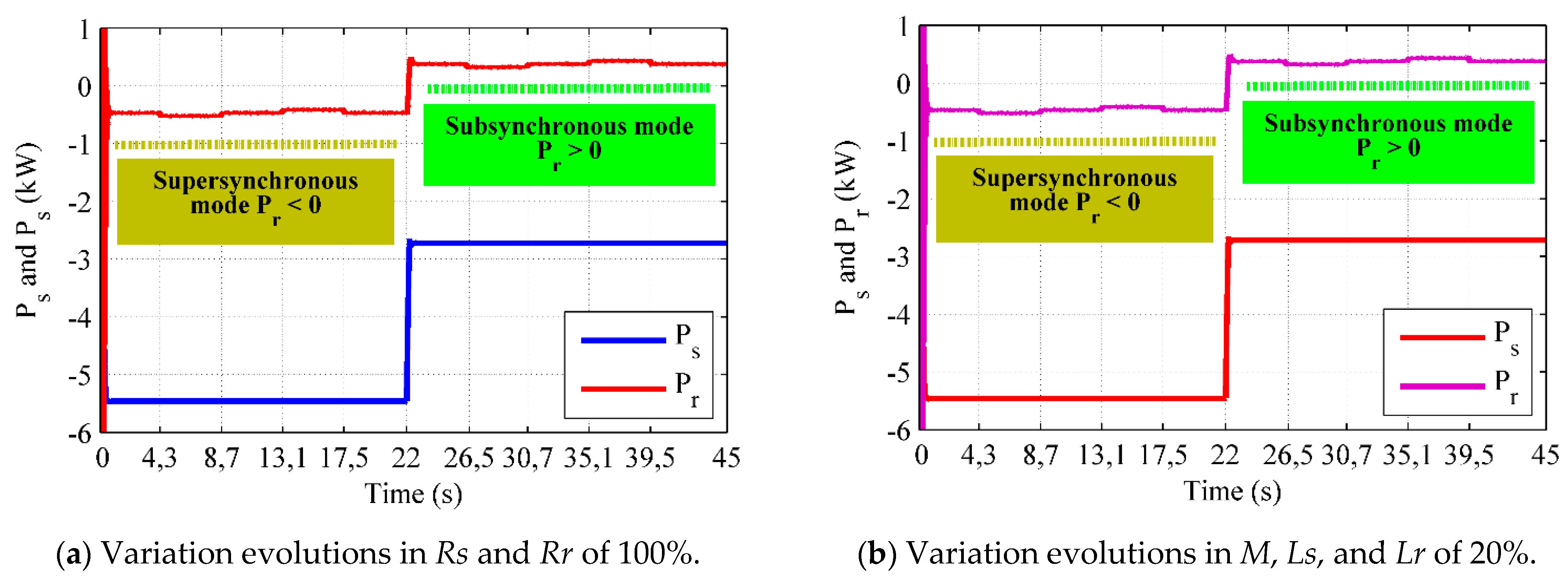



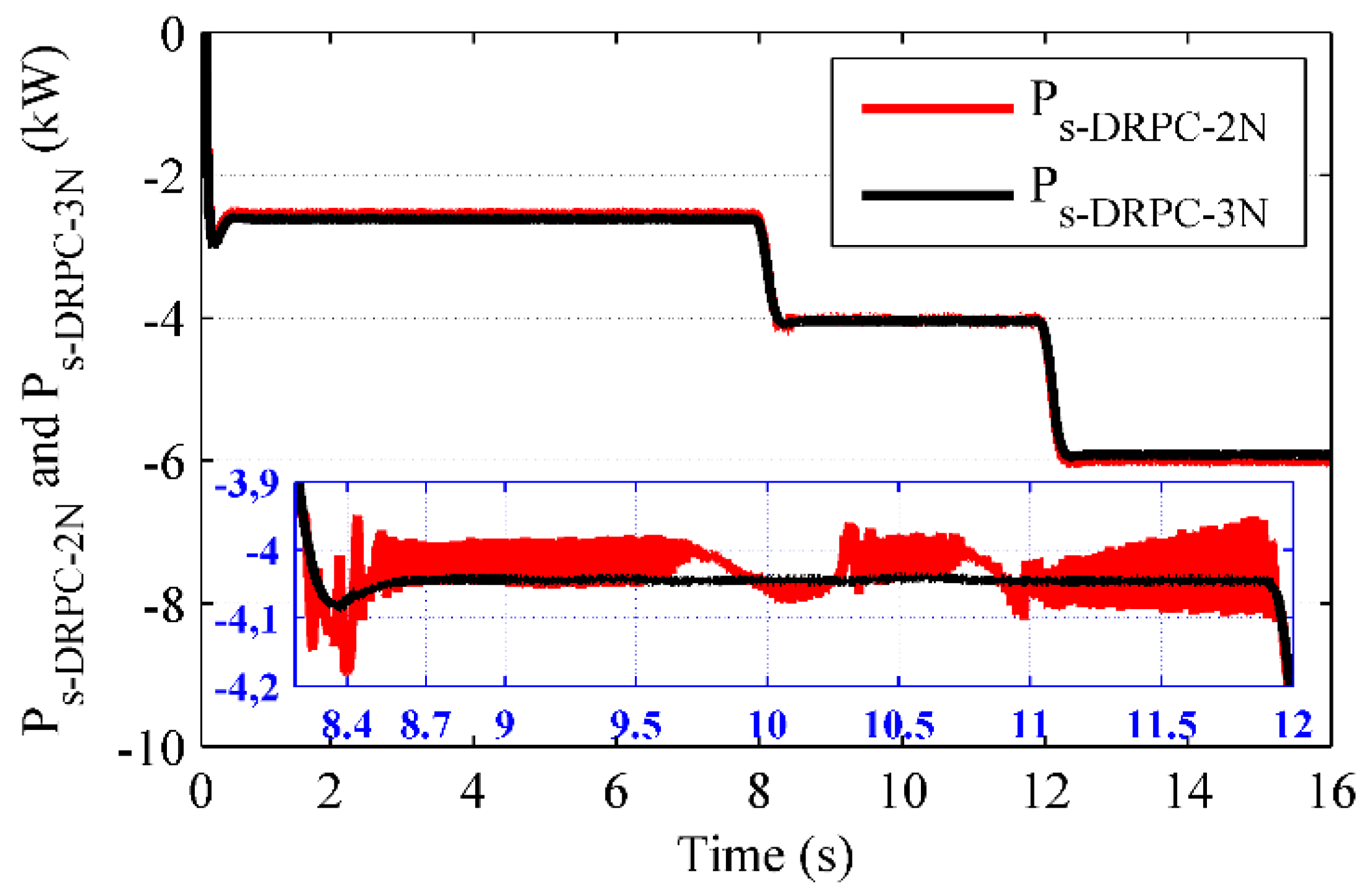
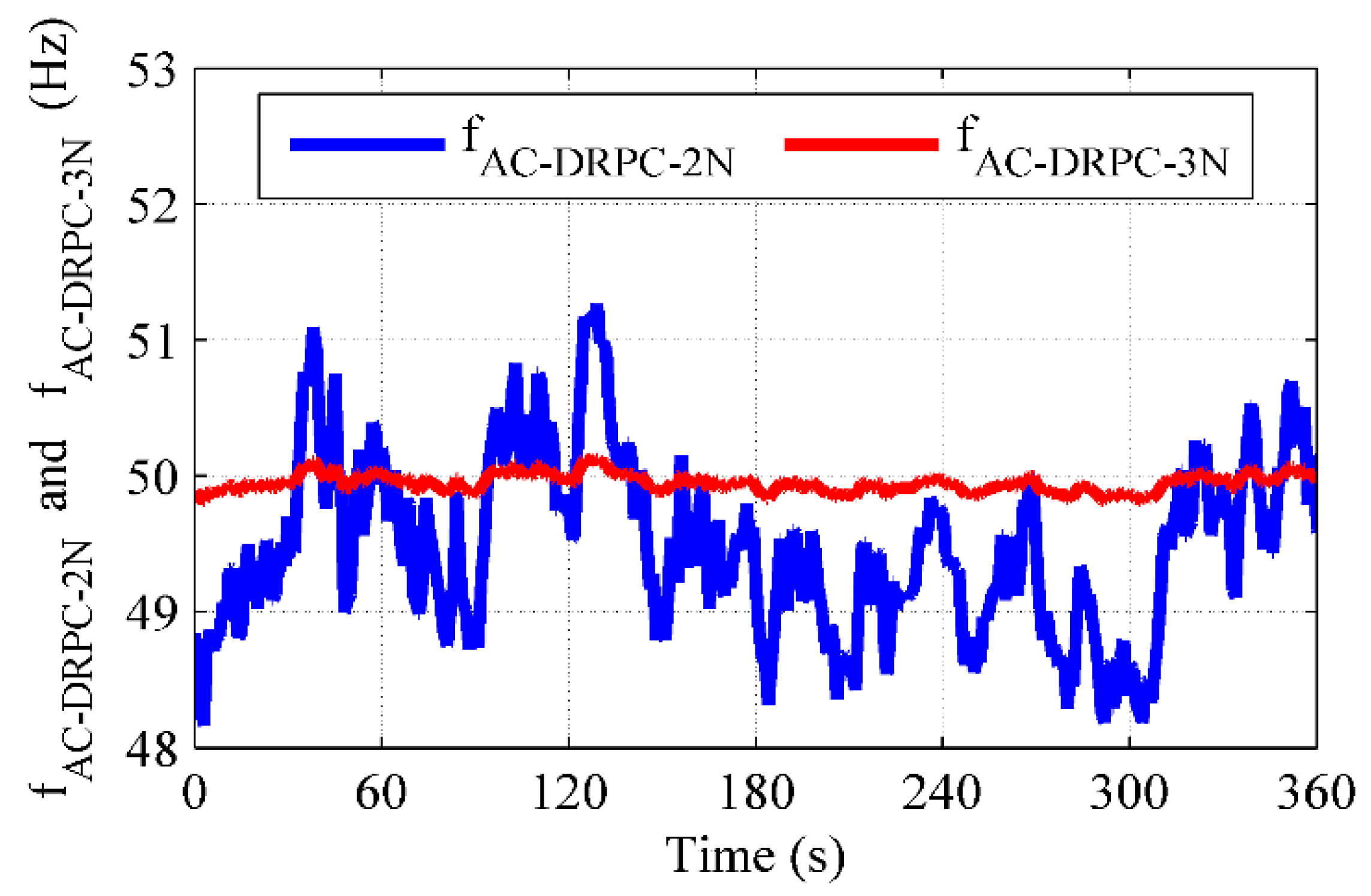
| Cflx | Ctrq | N | |||||||||||
|---|---|---|---|---|---|---|---|---|---|---|---|---|---|
| 1 | 2 | 3 | 4 | 5 | 6 | 7 | 8 | 9 | 10 | 11 | 12 | ||
| +1 | +2 | V21 | V16 | V22 | V17 | V23 | V18 | V24 | V19 | V25 | V20 | V26 | V15 |
| +1 | V21 | V2 | V22 | V3 | V23 | V4 | V24 | V5 | V25 | V6 | V26 | V1 | |
| 0 | Zero vector | ||||||||||||
| −1 | V26 | V1 | V21 | V2 | V22 | V3 | V23 | V4 | V24 | V5 | V25 | V6 | |
| −2 | V26 | V15 | V21 | V16 | V22 | V17 | V23 | V18 | V24 | V19 | V25 | V20 | |
| −1 | +2 | V17 | V23 | V18 | V24 | V19 | V25 | V20 | V26 | V15 | V21 | V16 | V22 |
| +1 | V3 | V23 | V4 | V24 | V5 | V25 | V6 | V26 | V1 | V21 | V2 | V22 | |
| 0 | Zero vector | ||||||||||||
| −1 | V5 | V25 | V6 | V26 | V1 | V21 | V2 | V22 | V3 | V23 | V4 | V24 | |
| −2 | V19 | V25 | V20 | V26 | V15 | V21 | V16 | V22 | V17 | V23 | V18 | V24 | |
| 0 | +2 | V22 | V17 | V23 | V18 | V24 | V19 | V25 | V20 | V26 | V15 | V21 | V16 |
| +1 | V22 | V3 | V23 | V4 | V24 | V5 | V25 | V6 | V26 | V1 | V21 | V2 | |
| 0 | Zero vector | ||||||||||||
| −1 | V25 | V6 | V26 | V1 | V21 | V2 | V22 | V3 | V23 | V4 | V24 | V5 | |
| −2 | V25 | V20 | V26 | V15 | V21 | V16 | V22 | V17 | V23 | V18 | V24 | V19 | |
| de/e | NL | NM | NS | ZR | PS | PM | PL |
| NL | NL | NL | NL | NL | NM | NS | ZR |
| NM | NL | NL | NL | NM | NS | ZR | PS |
| NS | NL | NL | NM | NS | ZR | PS | PM |
| ZR | NL | NM | NS | ZR | PS | PM | PL |
| PS | NM | NS | ZR | PS | PM | PL | PL |
| PM | NS | ZR | PS | PM | PL | PL | PL |
| PL | ZR | PS | PM | PL | PL | PL | PL |
| de/e | NL | NM | NS | ZR | PS | PM | PL |
| NL | NL | NL | NL | NL | PS | PS | PS |
| NM | NL | NL | NL | NM | PS | PS | PS |
| NS | NL | NL | NM | NS | PS | PS | PM |
| ZR | NL | NM | NS | ZR | PS | PM | PL |
| PS | NM | NS | NS | PS | PM | PL | PL |
| PM | NS | NS | NS | PS | PM | PL | PL |
| PL | NS | NS | NS | PS | PL | PL | PL |
| Ripples Mitigation: DRPC-3N Compared to DRPC-2N | ||||
|---|---|---|---|---|
| Tem | Φr | QAC | Ps | Generated Current Frequency |
| 60.7%. | 30.3%. | 20.1%. | 15.25% | 50.80% |
| DFIG Operations Modes | Sub-Synchronous | Synchronous | Super-Synchronous | |
|---|---|---|---|---|
| Percentage of generated current THD | DRPC-2N | 11.73% | 05.80% | 05.61% |
| DRPC-3N | 00.15% | 00.09% | 0.24% | |
Publisher’s Note: MDPI stays neutral with regard to jurisdictional claims in published maps and institutional affiliations. |
© 2021 by the authors. Licensee MDPI, Basel, Switzerland. This article is an open access article distributed under the terms and conditions of the Creative Commons Attribution (CC BY) license (https://creativecommons.org/licenses/by/4.0/).
Share and Cite
Tamalouzt, S.; Belkhier, Y.; Sahri, Y.; Bajaj, M.; Ullah, N.; Chowdhury, M.S.; Titseesang, T.; Techato, K. Enhanced Direct Reactive Power Control-Based Multi-Level Inverter for DFIG Wind System under Variable Speeds. Sustainability 2021, 13, 9060. https://doi.org/10.3390/su13169060
Tamalouzt S, Belkhier Y, Sahri Y, Bajaj M, Ullah N, Chowdhury MS, Titseesang T, Techato K. Enhanced Direct Reactive Power Control-Based Multi-Level Inverter for DFIG Wind System under Variable Speeds. Sustainability. 2021; 13(16):9060. https://doi.org/10.3390/su13169060
Chicago/Turabian StyleTamalouzt, Salah, Youcef Belkhier, Younes Sahri, Mohit Bajaj, Nasim Ullah, Md. Shahariar Chowdhury, Teerawet Titseesang, and Kuaanan Techato. 2021. "Enhanced Direct Reactive Power Control-Based Multi-Level Inverter for DFIG Wind System under Variable Speeds" Sustainability 13, no. 16: 9060. https://doi.org/10.3390/su13169060
APA StyleTamalouzt, S., Belkhier, Y., Sahri, Y., Bajaj, M., Ullah, N., Chowdhury, M. S., Titseesang, T., & Techato, K. (2021). Enhanced Direct Reactive Power Control-Based Multi-Level Inverter for DFIG Wind System under Variable Speeds. Sustainability, 13(16), 9060. https://doi.org/10.3390/su13169060










